
A street light, light pole, lamp pole, lamppost, streetlamp, light standard, or lamp standard is a raised source of light on the edge of a road or path. Similar lights may be found on a railway platform. When urban electric power distribution became ubiquitous in developed countries in the 20th century, lights for urban streets followed, or sometimes led.

Gas lighting is the production of artificial light from combustion of a fuel gas such as methane, propane, butane, acetylene, ethylene, hydrogen, carbon monoxide, coal gas or natural gas. The light is produced either directly by the flame, generally by using special mixes of illuminating gas to increase brightness, or indirectly with other components such as the gas mantle or the limelight, with the gas primarily functioning to heat the mantle or the lime to incandescence.

The history of street lighting in the United States is closely linked to the urbanization of America. Artificial illumination has stimulated commercial activity at night, and has been tied to the country's economic development, including major innovations in transportation, particularly the growth in automobile use. In the two and a half centuries before LED lighting emerged as the new "gold standard", cities and towns across America relied on oil, coal gas, carbon arc, incandescent, and high-intensity gas discharge lamps for street lighting.

Over-the-Rhine, often abbreviated as OTR, is a residential neighborhood located in the urban basin of Cincinnati, Ohio. Over-the-Rhine is among the largest, most intact urban historic districts in the United States. Originally settled by Ohio Rhinelanders, the neighborhood became home to significant African-American and Appalachian populations during the mid-20th century. It is home to several of Cincinnati's most famous landmarks, including Music Hall and Findlay Market.

A lamplighter or gaslighter is a person employed to light and maintain street lights. These included candles, oil lamps, and gas lighting.
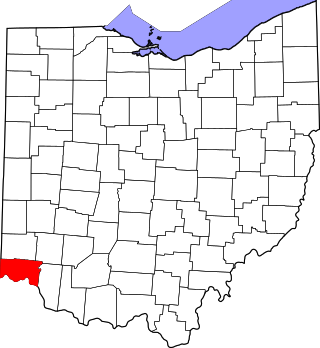
This is a list of the National Register of Historic Places listings in Hamilton County, Ohio.
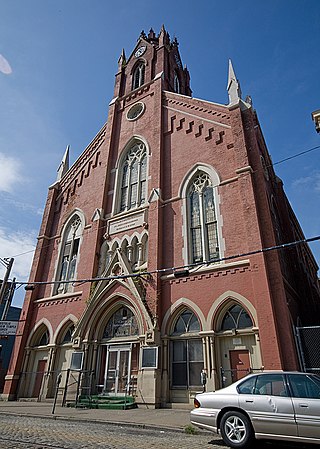
The Apostolic Bethlehem Temple Church is a historic church building in the Over-the-Rhine neighborhood of Cincinnati, Ohio, United States. A German Gothic Revival structure built in 1868, it was constructed as the home of the German Evangelical and Reformed Church, Cincinnati's oldest German Reformed Church. Founded in 1814, the church changed its name to "St. John's German Protestant Church" in 1874, although it remained in the German Reformed Church. This situation continued until 1924, when it departed for the American Unitarian Association and changed its name to "St. John's Unitarian Church." Little more than twenty years later, the congregation abandoned its old building, leaving it vacant until it was purchased by the present owners, a Pentecostal church.

The Glendale Historic District encompasses the historic core of Glendale, Ohio. Developed in 1851, Glendale is one of the earliest known examples of a planned residential village subdivision, its layout made using principles developed for rural cemeteries popular at the time. The district features shaded winding residential lanes, and a large assemblage of well-preserved period buildings. The district was designated a National Historic Landmark in 1977.
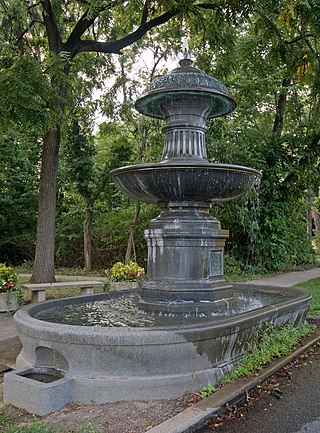
The Probasco Fountain is a large fountain in Cincinnati, Ohio, United States. Built of bronze on a base of granite, the fountain was constructed in 1887 according to a design by Samuel Hannaford.

The Saxony Apartment Building is a historic apartment building in Cincinnati, Ohio, United States. Located along Ninth Street in the city's downtown, this five-story brick building includes a distinctive range of architectural details. Among these elements are brick pilasters and projections, a three-story bay window on each side of the symmetrical main facade, semicircular balconies, and many stone pieces, such as pediments, keystones, and stringcourses. Due to its location at the intersection of Ninth and Race Streets, the Saxony appears to have two fronts: one onto each street. Although the Ninth Street facade is larger and more complex, the Race Street facade is nevertheless ornate as well: it features small yet elaborate semicircular balconies with wrought iron railings similar to those of the Ninth Street facade.
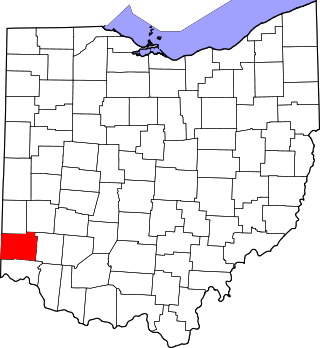
This is a list of the National Register of Historic Places listings in Butler County, Ohio.

This is a list of the National Register of Historic Places listings in Brown County, Ohio.

This is a list of the National Register of Historic Places listings in Cincinnati, Ohio.

The Charles H. Bigelow House is a historic building in Findlay, Ohio, United States, that was listed on the National Register of Historic Places on March 29, 2006. The home is considered to be a fine example of a Painted Lady, or polychrome Victorian architecture.
This is a list of the National Register of Historic Places listings in western Cincinnati, Ohio.
This is intended to be a complete list of the properties and districts on the National Register of Historic Places in downtown Cincinnati, Ohio, United States. Downtown Cincinnati is defined as being all of the city south of Central Parkway, west of Interstates 71 and 471, and east of Interstate 75. The locations of National Register properties and districts may be seen in an online map.
This is a list of the National Register of Historic Places listings in eastern Cincinnati, Ohio.
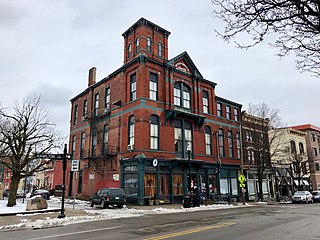
The Hoffner Historic District is a historic collection of buildings in the Northside neighborhood of Cincinnati, Ohio, United States. Built primarily at the end of the nineteenth century, the district has experienced few changes since it was built, and it has been named a historic site.

In Washington, D.C., street lighting is provided by the District of Columbia Department of Transportation, and covers all city streets and alleys. Because the Constitution of the United States makes the district a creature of the U.S. federal government, the federal government has the authority to regulate the type and appearance of street lighting. Congress has delegated a part of this authority to the Commission of Fine Arts, which controls the appearance of lighting standards in certain areas of the city.




















